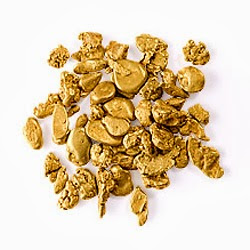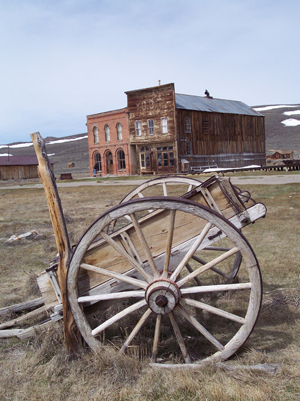Monday, October 19 2020
Are you excited about finding gold — ANY size gold? Most of us are, but if you want to sound like an old pro when referring to a Flour Gold: Gold particles that are barely visible to the naked eye. It’s so powdery, like flour, that it sometimes floats instead of sinks like heavier gold pieces. Flake Gold: A piece of gold that is large enough to easily spot, but is difficult to pick up with your fingers. Use tweezers. Fines: Particles of gold too small to pick up with your fingers. Combination of flake and flour gold. Picker: A piece of visible gold large enough to easily pick up with your fingers. Gold Nugget: Larger than a picker. A naturally formed lump of gold that is big enough to put in a poke and likely won't fit in a typical small vial, depending on its shape. Specimen: A naturally formed large gold nugget or gold-laced quartz specimen. Paydirt: Refers to dirt that has enough gold in it to be worth extracting. The term originated in the mid-1800 during the California Gold Rush. Today, you can even buy Alaska paydirt through the US Mail! Concentrates: All the gold-bearing material left in your sluice or trommel, etc. after using your gold recovery equipment - usually black sand mixed with fine gold. Fool’s Gold: The bane of any prospector’s existence! Iron or copper pyrites and mica can be mistaken for gold. The quickest and simplest test is to examine your sample in the shade, not in the sunlight. Real gold retains its yellow sheen even in shadow, whereas fool's gold does not. Real gold is soft and malleable; it can be cut with a knife and won't splinter. You can even "dent" it with a pin. Fool's gold, though, is hard and flaky. A drop of hydrochloric (muriatic) acid will tell you for sure. Real gold will not be affected, but if you see a slight foaming action and the sample begins to dissolve, you know it's not real gold. Color: Slang for any amount or size of visible gold that you find in your gold pan. Au: Gold is element 79 and its symbol is Au on the periodic table. As a pure metal, gold is extremely heavy with a specific gravity of 19.3, which means pure gold weighs 19 times more than an equal amount of water.
Thursday, October 08 2020
Has Covid-19 put the kibosh on local haunted houses, trick-or-treating, and Halloween parties this year? Not to worry, you can still find some socially distant ghostly fun this season— visit a gold mining ghost town! About 3,800 ghost towns are still standing across the USA, mostly out West. Some of the buildings are in great condition, others are quite literally falling down. Some towns have become well-known, easy-to-reach roadside attractions, others are quite remote. Each town has its own boom-to-bust story that makes a visit both interesting and educational. Whether you’re a ghost hunter or a history buff, please leave everything as you find it. Take lots of photos, but no souvenirs.
Bodie State Historic Park, California. When a little girl writes in her diary “Goodbye God, I’m going to Bodie” you know her Oatman, Arizona. If you’re out to get some kicks on historic Route 66, stop in the ghost town of Oatman, Arizona. Born as a tent camp for gold miners in 1906, the town boomed, then busted in the 1940s, and has since come alive again. Over half a million tourists visit Oatman each year, greeted by friendly resident burros looking for a carrot snack! Although there are gift shops, staged gunfights, and costumed entertainers strolling the streets, Oatman takes pride in keeping the flavor of the town as authentic as possible. You won’t find newly renovated buildings here—Oatman’s historic buildings are definitely from a bygone era. As you stroll through town, watch for signs and painted murals. One particular interesting sign shares the history of the Oatman name. It was originally named Vivian, after the Vivian Mining Company. It was later renamed Oatman in honor of Olive Oatman, a woman kidnapped by Indians in the 1850s, and released five years later for a ransom of one horse, four blankets, and some beads. Signs also tell you that the town appeared in several movies such as How The West Was Won, Foxfire and Edge of Eternity. Bannack State Park, Montana. Although the old-time prospectors are long gone, many mining relics and over 60 buildings remain at Montana’s Bannack State Park. Most are so well preserved that you can actually go inside them— a rare treat when it comes to ghost gowns. Bannack’s rich history began 150 years ago with John White’s discovery of placer gold along the banks of Grasshopper Creek. In July 1862, Mr. White filed one of the first recorded mining claims in what was later to become the state of Montana. Good news traveled fast and by fall of that year, “Grasshoper Diggins” was home to 400 prospectors. By the following spring, the population had swelled to 3,000 — the Gold Rush was definitely on! On the southeast end of Bannack, the Bessette House is believed to be haunted by the children who died here during an epidemic of scarlet fever. The site is nicknamed the Crying Baby House because of the sounds some visitors have reported hearing. Keep the old timers in mind as you stroll through these or any other gold mining ghost town. It will give you a new appreciation for modern gold mining equipment and metal detectors that makes gold recovery so much quicker and easier. It really puts into perspective yesteryear’s impact on the gold mining we do today. Find more information on ghost towns, gold mine tours, and travel articles on historic sites here. |
|
Nugget of News Blog |







